Oklahoma Weather: A Comprehensive Guide to the State’s Diverse Climates
Oklahoma, known for its vast plains and rolling hills, experiences a diverse range of weather patterns throughout the year. Understanding Oklahoma’s weather is crucial for residents and visitors alike, as it significantly impacts daily life, agriculture, and outdoor activities. This comprehensive guide will delve into the intricacies of Oklahoma’s climate, exploring its seasonal variations, extreme weather events, and the factors contributing to its unique weather characteristics.
Seasonal Variations in Oklahoma Weather
Oklahoma’s weather is highly variable, influenced by its geographical location in the southern Great Plains. The state experiences four distinct seasons, each with its own set of characteristics:
Spring (March-May):
Spring in Oklahoma brings warmer temperatures and increased rainfall. While pleasant days abound, the transition from winter to spring can be erratic, with occasional cold snaps and unpredictable precipitation. Thunderstorms become more frequent, often accompanied by hail and strong winds. This period marks the beginning of the tornado season, a significant weather concern in the state.
Summer (June-August):
Oklahoma summers are hot and humid, with temperatures regularly exceeding 90°F (32°C). Heat waves are common, posing health risks. Afternoon thunderstorms are frequent, sometimes leading to flash flooding in low-lying areas. The combination of heat and humidity creates ideal conditions for the development of severe thunderstorms and tornadoes.
Autumn (September-November):
Autumn brings a welcome respite from the summer heat, with cooler temperatures and drier conditions. However, autumn also sees the continuation of the tornado season, although the frequency of severe storms typically decreases. The vibrant colors of fall foliage add to the beauty of the landscape, attracting visitors from across the country.

Winter (December-February):
Oklahoma winters are generally mild compared to other states in the same latitude, but they can still experience periods of cold temperatures, ice, and snow, particularly in the northern and higher-elevation areas. While snowfall is not consistently heavy across the state, ice storms can pose significant challenges, leading to power outages and hazardous road conditions. The risk of winter storms is a significant weather concern, requiring preparedness from residents.
Extreme Weather Events in Oklahoma
Oklahoma is notorious for its susceptibility to extreme weather events. Understanding these events is essential for ensuring safety and preparedness:
Tornadoes:
Oklahoma is located within Tornado Alley, a region of the United States known for its high frequency of tornadoes. The combination of warm, moist air from the Gulf of Mexico and cold, dry air from the west creates the perfect conditions for the formation of supercell thunderstorms, which can produce devastating tornadoes. Tornado preparedness is crucial for all Oklahoma residents.
Severe Thunderstorms:
Severe thunderstorms are a common occurrence in Oklahoma, particularly during the spring and summer months. These storms can produce high winds, large hail, and torrential rainfall, leading to flash flooding and property damage. Staying informed about weather forecasts and taking appropriate precautions is essential during severe thunderstorm activity.
Hailstorms:
Oklahoma experiences frequent hailstorms, with some hailstones reaching significant sizes. Large hail can cause significant damage to property, including vehicles and buildings. Hailstorms are often associated with severe thunderstorms and can be unpredictable.

Flash Floods:
Flash floods are a serious threat in Oklahoma, particularly during periods of heavy rainfall. The state’s relatively flat terrain can exacerbate the impact of heavy precipitation, leading to rapid rises in water levels and the potential for significant damage. Being aware of flood warnings and taking appropriate precautions is vital.
Droughts:
Oklahoma is also prone to periods of drought, which can severely impact agriculture and water resources. Droughts can last for extended periods, leading to water restrictions, crop failures, and wildfires. Understanding drought conditions and practicing water conservation is important for the state’s resilience.
Factors Influencing Oklahoma Weather
Several factors contribute to Oklahoma’s unique and often unpredictable weather patterns:

- Geographic Location: Situated in the southern Great Plains, Oklahoma is at the intersection of several major air masses, leading to frequent weather changes.
- Elevation: The state’s relatively flat terrain allows for the unimpeded movement of air masses, contributing to the frequency of severe weather events.
- Jet Stream: The jet stream’s position and strength significantly influence Oklahoma’s weather, directing the movement of air masses and contributing to the formation of severe storms.
- Gulf of Mexico Moisture: The proximity to the Gulf of Mexico provides a source of warm, moist air that fuels the development of thunderstorms and tornadoes.
Staying Safe During Oklahoma Weather Events
Safety during Oklahoma weather events is paramount. Staying informed about weather forecasts and warnings, having an emergency plan, and knowing what to do during different weather events are crucial for protecting yourself and your family.
Resources like the National Weather Service (NWS) provide valuable information and warnings, and it’s essential to monitor these sources regularly, especially during severe weather season.
Understanding Oklahoma’s weather is not just about knowing what to expect; it’s about preparing for the unexpected. By understanding the state’s diverse climates, extreme weather events, and safety precautions, you can navigate the often-challenging weather patterns and ensure your safety and well-being.

